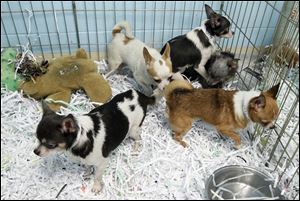
State developing rules for breeders
Ohioans urged to speak out on puppy mills
8/12/2013
These Chihuahuas at the Toledo Area Humane Society in Maumee were taken from a puppy mill in Shelby, Ohio. The Humane Society wants new rules to ensure dogs have enough space and exercise.
Both the American Society for the Protection of Companion Animals and the Humane Society of the United States are urging Ohio residents to speak out against commercial dog-breeding facilities operated with an emphasis on profits above animal welfare.
Both the American Society for the Protection of Companion Animals and Humane Society of the United States are urging members to attend the public hearing Aug. 29, starting at 9 a.m. at 8995 E. Main St., Reynoldsburg.
People who wish to present their positions, arguments, or contentions in writing, other than at the public hearing, may do so by either mailing their written comments to the Ohio Department of Agriculture, c/o Legal Section, 8995 E. Main St., Reynoldsburg, OH 43068; or by sending a fax to 614-995-4585.
Written comments sent by mail must be postmarked no later than the day of the hearing. Comments sent by fax should be sent no later than 5 p.m. on the day of the hearing.
The groups have each sent out emails to Ohio supporters urging them to contact David Daniels, director of the Ohio Department of Agriculture.
Last year Ohio lawmakers passed Senate Bill 130, introduced by State Rep. Dave Hall (R., Millersburg), to regulate dog-breeding kennels and retailers. Now, the state agriculture department is working on establishing exactly what kind of housing, veterinary care, food, and record-keeping standards will be acceptable and what will be illegal going forward.
The department recently proposed rules to outline basic care requirements for dogs in puppy mills. While the 19 pages of proposed rules include some basic standards, the humane society says they must be stronger to ensure that dogs have enough space, exercise, and protection from the heat and cold.
The humane society urged its supporters on Monday to contact Mr. Daniels and let him know that the draft rules are a good first step, but some provisions are needed in order to address effectively the scale of the problems found in Ohio’s puppy mills.
The ASPCA sent a similar email last week to its Ohio mailing list.
“It is critical that the Ohio Department of Agriculture write animal-care standards that are better than the federal government’s, which are decades old and allow dogs to be kept in tiny, wire-bottomed cages for their entire lives, exposed to extreme heat and cold without adequate veterinary care, socialization or exercise,” according to the ASPCA.
The ASPCA is urging state officials to enact stronger standards of care — including improvements to housing, socialization, and vet care — and to close a loophole in the proposed regulations that would allow USDA-licensed breeders in Ohio an exemption from the state’s new commercial breeding standards of care until December, 2016.
Karen Minton, the Ohio director for the Humane Society of the United States, will present testimony on behalf of the group at the hearing.
“We are definitely requesting some improvements to the standards,” Ms. Minton said. “Our main focus is increasing the proposed cage size, ensuring dogs aren’t forced to endure extreme temperatures and ensuring each dog receives regular exercise and respite from their enclosure.”
The proposed rules require doubling the USDA cage size for the first dog, then adding floor space as required by the USDA.
“It stands to reason that if a single dog requires two times the floor space required by the USDA, that an additional dog requires the same amount of space, and not less,” she said.
In some cases, the proposed rule contradicts federal regulations, she added.
“The USDA requires the minimum floor space to be the square of the length of the adult dog or puppy in inches, as measured from the tip of the nose to the base of the tail, plus six inches,” Ms. Minton said. “The draft rule states existing facilities may use primary enclosures that do not meet the space requirements of the USDA until the grandfathering date. Since an ‘existing facility’ must be USDA licensed, it must also meet USDA regulations and it should be required to do so immediately upon the effective date of the rules.”
The rules should also address excessive temperatures, she said.
“The proposed rules should require licensed facilities to be kept between 50 and 85 degrees Fahrenheit at all times,” said Ms. Minton, adding that the rules also need to specify:
● Gridded or “open” flooring not have any gaps large enough to entrap toes or any part of a dog’s paws.
● Clean, potable water should be provided at all times, not just twice daily.
● Daily exercise be required, but to ensure the ability for enforcement, exercise pens, as well as mandated respite from their cages for a specific duration.
Contact Tanya Irwin at: tirwin@theblade.com, 419-724-6066, or on Twitter @TanyaIrwin.